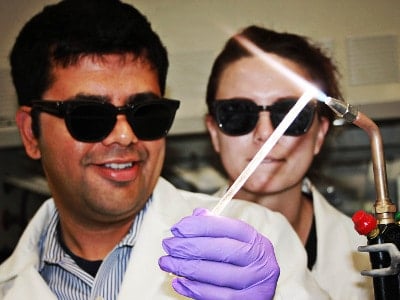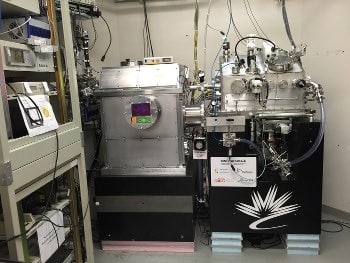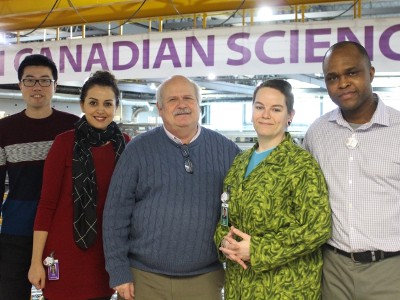

A team working out of Texas A&M University, led by chemist Sarbajit Banerjee, has been using the the Scanning Transmission X-ray Microscope (STXM), one of the world’s most powerful soft X-ray microscopes at the Canadian Light Source in Saskatchewan, to study one of the mysteries of battery storage, a scourge of modern life that keeps us all constantly recharging devices and searching for electrical outlets.
If you have been stranded recently by a discharged battery, then this research should mean something to you.
Banerjee and his team have published their research in the latest edition of Nature Communications, titled “Mapping polaronic states and lithiation gradients in individual V2O5 nanowires”, which outlines their efforts at understanding how lithium ions behave in a battery, and how batteries could be improved by using nanotechnology to make it easier for lithium ions to do what we want them to do.
“The inadequacies of Li-ion batteries have emerged as a major constraint in many areas of technological design and can be attributed in large measure to challenges with the identification of optimal cathode chemistries and architectures,” reads the team’s Nature paper.
Solving the problem of “optimal” architectures in lithium-ion batteries will obviously also have a huge impact on the burgeoning field of electric vehicles and a range of other industrial applications that are currently hampered by sub-optimal battery storage capacities.
“One of the things we look at is, why do devices like cell phones and computers use up so much energy?” said Dr. Banerjee to Texas A&M Science. “We’re trying to develop new materials to make better circuits that are less energy guzzling. This work hones in on the problem, and it’s a really good measurement. In the end, we were able to get to the bottom of the problem.”

To conduct this measurement, Banerjee and his team headed to Saskatchewan, to use the Canadian Light Source’s soft x-ray microscope.
“This facility is one of the few places in the world that has such a beam that you can shrink down,” said Dr. Banerjee. “So you’re not only taking an X-ray of an object, you’re shrinking it down — taking an X-ray image down to about 30 nanometers pixel size. That’s really what allowed us to see what we did. It’s a very powerful microscope that’s one of its kind, and it allows us to solve these problems.”
And what are these problems? In theory, lithium ions should flow freely from one electrode to the other as it charges and discharges, mediated by an electrolyte.
But somewhere in that process, the ions get trapped, emptying one of the electrodes until the battery becomes dead, a phenomenon that is still poorly understood by researchers, which they metaphorically refer to as a lithium ion “traffic jam”.
“For a battery to function properly, you need to get lithium ions in, and you need to be able to pull them out,” said Banerjee. “Once our lithium ions got in, we were seeing that they sort of stop at some point along the way.”
Using the soft x-ray telescope at the Canadian Light Source, the researchers were finally able to identify the specific site where these traffic jams happen and what material conditions prevent lithium ions from flowing freely.
“You can always draw an analogy between water and electrons,” said Dr. Banerjee. “They are making these little puddles, but until the puddles are connected, they can’t flow. Once you have enough electrons coming in, they can all link up and start flowing. But until that happens, they’re all stranded, and they can’t move to charge or discharge something. And so they go out and hang in different areas of the particle. They’re all sort of sitting, defining different regions, and they aren’t able to move easily.”
There are several candidates for nanostructured materials that might facilitate the development of a battery that doesn’t constantly need to be replenished, such as vanadium pentoxide, but while those materials show great promise in the lab, they still need real-world road testing.
The team’s research is funded by the National Science Foundation in the U.S., with contributing scientists from the University of California Berkeley Lab’s Molecular Foundry, and a U.S. Department of Energy National User Facility for Nanoscale Science Research, with calculations verified by colleagues from Binghampton using National Synchrotron Light Source beamlines at Brookhaven National Laboratory in Upton, New York.
Leave a Reply
You must be logged in to post a comment.






 Share
Share Tweet
Tweet Share
Share




Comment